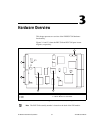
Chapter 4 Functional Overview
© National Instruments Corporation 4-3 NI 7340 User Manual
Flash Memory
Nonvolatile memory on the 7340 is implemented with flash ROM, which
means that the controllers can electrically erase and reprogram their own
ROM. Because all the 7340 embedded firmware, including the RTOS and
DSP code, is stored in flash memory, you can upgrade the onboard
firmware contents in the field for support and new feature enhancement.
Flash memory also allows objects such as programs and data arrays to be
stored in non-volatile memory. It is possible to save the entire parameter
state of the controller to the flash memory. On the next power cycle, the
controller automatically loads and returns the configuration to these new
saved default values.
The FPGA configuration programs also are stored in the flash ROM.
At power-up, the FPGAs are booted with these programs, which means
that updates to the FPGA programs can be performed in the field.
A flash memory download utility is included with the NI-Motion software
that ships with the controller.
Axes and Motion Resources
The 7340 can control up to four axes of motion. The axes can be completely
independent, simultaneously coordinated, or mapped in multidimensional
groups called coordinate spaces. You also can synchronize coordinate
spaces for multi-vector space coordinated motion control.
Axes
At a minimum, an axis consists of a trajectory generator, a PID (for servo
axes) or stepper control block, and at least one output resource—either
a DAC output (for servo axes) or a stepper pulse generator output. Servo
axes must have either an encoder or ADC channel feedback resource.
Closed-loop stepper axes also require a feedback resource, while open-loop
stepper axes do not. Figures 4-1 and 4-2 show these axis configurations.
With the 7340, you can map one or two feedback resources and one or two
output resources to the axis. An axis with its primary output resource
mapped to a stepper output is by definition a stepper axis. An axis with its
primary output resource mapped to a DAC is by definition a servo axis.


















